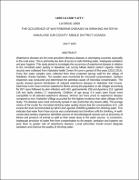| dc.contributor.author | Nafi’u, Abdulkadir | |
| dc.date.accessioned | 2017-06-28T07:58:02Z | |
| dc.date.available | 2017-06-28T07:58:02Z | |
| dc.date.issued | 2015 | |
| dc.identifier.citation | Nafi’u,A.(2015) The Occurence of Waterborne diseases in drinking water in Nakaloke Sub-County, Mbale District Uganda. Thesis (Masters). Islamicuniversity in Uganda. | en_US |
| dc.identifier.uri | http://hdl.handle.net/20.500.12309/238 | |
| dc.description.abstract | Waterborne Diseases Are The Most Prevalent Infectious Diseases In Developing Countries Especially In The Rural Areas. This Is Primarily Due Lack Of Access To Safe Drinking Water, Inadequate Sanitation And Poor Hygiene. This Study Aimed To Investigate The Occurrence Of Waterborne Diseases In Relation To The Microbial Water Quality In Nakaloke Sub County Mbale District Eastern Uganda. Patient Records Were Collected From Nakaloke Health Centre Iii Cover A Period Of Five Years (2010-2014). Forty Five Water Samples Were Collected From Three Protected Springs Well For The Village Of Nakaloke; Kireka Nandala. The Samples Were Monitored For Microbial Contamination. Sanitary Inspection Was Conducted And Determined The Potential Causes Of Microbial Contamination. The Results Showed General Distribution Of Selected Waterborne Diseases In Nakaloke Sub County. Diarrhoea Is The Most Common Waterborne Illness Among The Population In All Villages Accounting For 837 Cases Followed By Skin Infection With 453, Gastroenteritis 258 And Dysentery 213, Typhoid 148 And Lastly Cholera 17 Respectively. Children Of Age Group 0-5 Years Were Found More Susceptible To All Selected Waterborne Diseases. Women Are More Prone To Waterborne Diseases Compared To Men, Nakaloke Village Accounted For The Highest Incidence Than Other Villages Of The Study. The Diseases Were Most Commonly Spread In Wet (1440) Than Dry Season (486). The Average Means Of The Results For Microbial Drinking Water Quality Shows That The Concentrations Of E. Coli Exceed The Level Recommended By Who And Ugandan Dwrm Guideline For Drinking Water. This Indicates That Water From These Sources Was Contaminated And Therefore Unfit For Drinking. A Well-Constructed Sanitary Inspection Identified Sources Of Microbiological Hazards Such As Proximity Of Latrine And Presence Of Animal As Well As Their Waste Close To The Water Sources. In Conclusion, Inadequate Provision Of Water Free From Contamination To The People, Sanitation And Hygiene Can Pose Them To Greater Risk Of Waterborne Diseases. Local Authorities Should Ensure Adequate Sanitation And Improve The Quality Of Drinking Water. | en_US |
| dc.language.iso | en | en_US |
| dc.subject | Waterborne diseases | en_US |
| dc.subject | Mbale | en_US |
| dc.subject | water | en_US |
| dc.title | The Occurence of Waterborne diseases in drinking water in Nakaloke Sub-County, Mbale District Uganda | en_US |
| dc.type | Thesis | en_US |

